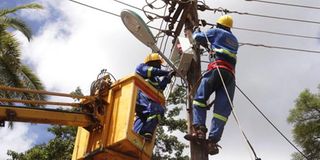Historic Ugandan power imports on long drought

Kenya Power staff at work in Nyeri. Electricity consumers have been handed a relief after the energy regulator retained power prices for the third month in a row.
Low hydropower generation due to prolonged drought forced Kenya to increase electricity imports from its neighbour Uganda to a historic high to plug the deficit.
Data released by the Kenya National Bureau of Statistics (KNBS) yesterday shows Kenya imported 34.14 million kilowatt-hours (kWh) of electricity from Uganda in February – the highest amount imported from that country on record – up from imports of 30.34 million units in January.
“Total local electricity generation decreased from 1,026.03 million KWh in January 2022 to 926.40 million KWh in February 2022,” said KNBS. Kenya was hit by a biting drought for months last year due to unreliable rains, which saw President Uhuru Kenyatta declare it a national disaster with water levels in the country’s key rivers for hydropower generation such as River Tana dropping affecting electricity generation.
The data shows hydropower generation fell to just 244.23 million units in February – the lowest since September 2019 generation of 233.8 million units – down from 320.3 million units in January, forcing Kenya Power to increase its imports of cheaper hydro from Uganda.
The period saw power generation decrease across all sources including hydro, wind, solar and geothermal only except for thermal generation which was increased to compensate for the generation shortfall from the other sources. Geothermal power generation also fell to just 304.77 million kWh – the lowest since September 2014 – down from 310.79 million units in January after State-owned power generator KenGen shut down one of its major geothermal power plants for maintenance.
Data from the Energy and Petroleum Regulatory Authority shows the 140-megawatt (MW) Olkaria 1 Unit IV and V geothermal power plant produced just 6kWh of electricity in February signaling that it was offline. The plant generates more than 90 million units of electricity when running at full capacity.
Kenya’s power imports from Uganda largely serve the western parts of the country which for decades experienced frequent power shortages due to reliance on relies on the 65MW diesel generator in Muhoroni and the imports from Uganda to serve homes and industries.
However, the commissioning of the Sh16 billion Olkaria-Lessos-Kisumu power transmission line that evacuates stable power from the Olkaria geothermal fields in Naivasha last year has been touted as a game-changer in stabilising the electricity supply in the region.
This comes as local power demand has surged to historic highs driven by a recovering economy that has seen the reopening of large manufacturers, who are the largest consumers of power in the country.




